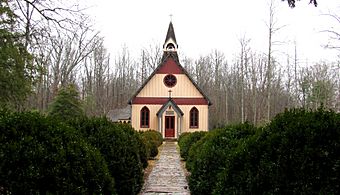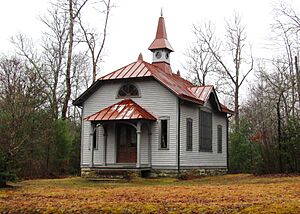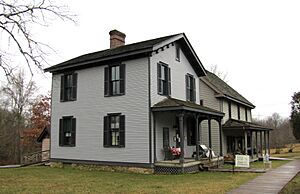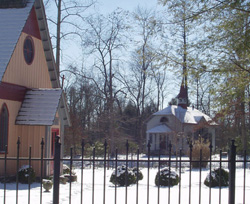Rugby, Tennessee facts for kids
Quick facts for kids |
|
|
Rugby Colony
|
|

Christ Church Episcopal at Rugby
|
|
| Location | TN 52 Rugby, Tennessee |
|---|---|
| Nearest city | Huntsville, Tennessee |
| Area | 525 acres (212 ha) |
| Built | 1880 |
| Architectural style | Gothic |
| NRHP reference No. | 72001249 |
| Added to NRHP | April 26, 1972 |
Rugby is a small community in Morgan and Scott counties in Tennessee. It was started in 1880 by an English writer named Thomas Hughes. He wanted Rugby to be a special place where people could try out new ideas for living together.
Hughes imagined Rugby as a colony where younger sons from English families could own land. Many of these young men had no jobs because of old laws and tough economic times in England. He hoped Rugby would be a place free from the problems of big cities. The community was meant to focus on everyone being equal and working together, following ideas from Hughes's book Tom Brown's School Days.
However, Rugby faced many difficulties from the start. A serious sickness spread quickly in 1881, and there were legal fights over who owned the land. Many people who moved there were not used to the hard farm work needed on the Cumberland Plateau. By 1887, most of the first settlers had left or passed away. Still, a small group of people continued to live in Rugby through the 1900s.
In the 1960s, people who loved Rugby began working to bring back its original look. They fixed old buildings and rebuilt others. Today, Rugby's beautiful old buildings and lovely setting make it a popular place for visitors. In 1972, the historic part of Rugby was added to the National Register of Historic Places.
Contents
Where is Rugby Located?
Rugby sits on top of the Cumberland Plateau. It is near where Morgan, Scott, and Fentress counties meet. Most of the community is in Morgan County.
To the north of Rugby, two streams, the Clear Fork and White Oak Creek, join together. This spot is called "The Meeting of the Waters" and has been a favorite hiking place for a long time. The Clear Fork then flows northeast to join the New River. Together, they form the Big South Fork of the Cumberland River.
State Route 52 used to go through Rugby. But in 2013, a new road called the "Rugby Bypass" opened. This new road connects Rugby to U.S. Route 127 in Jamestown and U.S. Route 27 in Elgin. The area around Rugby is quite remote. The huge Big South Fork National River and Recreation Area is to the north. Rolling hills stretch for miles to the south with few people living there.
Rugby's Story
How Rugby Began
Thomas Hughes was born in England in 1822. He went to the Rugby School as a boy. The school's leader, Thomas Arnold, greatly influenced him. Hughes later named his community in Tennessee after this school. In his book Tom Brown's School Days, Hughes shared his ideas about people working together and owning businesses as a community.
By the 1860s, Hughes was unhappy with how much people in England cared about money and things. He felt that many young English men were wasting their talents. This was due to tough economic times and an old system where only the oldest son inherited family land.
In 1870, Hughes visited America. He learned about a group called the Board of Aid to Land Ownership. This group helped city workers move to the countryside. Hughes thought this idea could also help young, jobless English gentlemen. In 1878, a leader from the Board of Aid and a railway agent found the perfect spot for Rugby on the Cumberland Plateau. They loved its untouched forests, clean air, and beautiful gorges. They bought options for thousands of acres of land.
Hughes then partnered with British lawyers and bought the Board of Aid. This allowed him to start his dream community.
Life in Rugby (1880-1887)
The town of Rugby was planned to feel like a resort. It was about 7 miles from the nearest train stop. The first building, called the "Asylum" (now Pioneer Cottage), was built in early 1880. The first settlers quickly built tennis and croquet courts. They also made a path to "The Meeting of the Waters." Soon, many homes were finished, along with a three-story hotel called the Tabard Inn.
Thomas Hughes officially opened the colony on October 5, 1880. He explained his plans for Rugby. Everyone living there had to invest a small amount of money in the community store. This made sure everyone had a share. People had personal freedoms, but selling alcohol was not allowed. The community would build an Episcopal church that any Christian group could use.
Newspapers in America and London wrote about Rugby's progress. Rugby even had its own newspaper, The Rugbeian. Many settlers started a Library and Reading Room Society. In the summer of 1881, a serious sickness called typhoid spread. Seven settlers died, and the Tabard Inn had to close for cleaning. But the community recovered. By 1884, Rugby had over 400 residents, 65 buildings, a tennis team, and social clubs. In 1885, a university called Arnold School was started.
Tough Times and Changes
From the beginning, Rugby faced legal problems over land ownership. Many local people were unsure about selling their land. This slowed down the colony's growth, and many settlers left. Also, the person who chose the town's location focused on its beauty, not on the poor soil for farming.
The Tabard Inn, Rugby's main hotel, closed because of the typhoid sickness in 1881. It then burned down in 1884. This hurt Rugby's growing tourism and the Board of Aid's finances.
In 1882, the leaders in London replaced the colony director. Rugby tried to start a tomato canning factory in 1883. But after the factory was built, they couldn't grow enough tomatoes to keep it running. Newspapers started to make fun of Rugby. Some said Hughes had created a "pleasure picnic" instead of a real working community.
In 1887, several important settlers passed away, including Hughes's mother. This led most of the original settlers to leave Rugby. That year, Hughes made his last yearly visit to the colony, and The Rugbeian newspaper stopped printing. By 1900, the company that owned Rugby's land had sold it all. They had given up on the original ideas of the colony.
Saving Rugby's History
William Walton (1887–1958), the son of an early director, took care of the Thomas Hughes Library, Christ Church Episcopal, and Kingstone Lisle for many years. Other families also looked after historic homes.
Efforts to protect Rugby began in the 1940s. Logging companies were cutting down the old forests around the community. News articles in major newspapers helped spread the word. Even with federal support, the state of Tennessee did not buy the land from the logging companies. So, the forest was cut right up to Rugby's edges.
In 1966, a group called Historic Rugby was formed. This non-profit group works to restore and care for the old buildings that are still standing. These include Christ Church Episcopal, the Thomas Hughes Library, the Rugby School, Kingstone Lisle, Uffington House, and Newbury House.
The group has also rebuilt several buildings to look like their originals. These include the Board of Aid office, the Rugby Commissary, and Sir Henry Kimber's Percy Cottage. The Harrow Road Cafe, a restaurant built in the 1980s, was named after an old Rugby restaurant. The Cafe was destroyed by fire in September 2020. The Rugby Printing Works was moved to Rugby in the 1970s from a nearby town. Historic Rugby also allows new homes to be built in the Beacon Hill area. But these new homes must match Rugby's old Victorian style.
Important Buildings in Rugby
Christ Church Episcopal
The Christ Church Episcopal was started on October 5, 1880. At first, services were held in the original Rugby schoolhouse. The church building you see today was built in 1887. It was designed in a style called Carpenter Gothic. The church's special offering plate was made by an English carpenter. The church's reed organ, built in 1849, is one of the oldest in the United States. People have met for church services here regularly since 1887.
Thomas Hughes Library
The Thomas Hughes Library was built in 1882. It looks almost exactly as it did when it was first built. The library has about 7,000 books. Most of these books were given to Rugby's Library and Reading Room Society. The only condition was that they name the new library after Thomas Hughes. The library still has most of its original collection. The oldest book dates back to 1687. Edward Bertz, Rugby's first librarian, wrote a book about his experiences in Rugby.
Kingstone Lisle
Kingstone Lisle is a pretty cottage built in 1884. It is in the Queen Anne style. It was meant to be Thomas Hughes's home. However, Hughes only stayed there for a very short time during one of his visits. He usually stayed at Newbury House. In the late 1880s, Hughes gave the house to the Christ Church priest to use as a home. Historic Rugby restored the house in the 1960s. It is now decorated with furniture from that time period.
Other Historic Buildings
Rugby has many other interesting old buildings. Each one tells a part of the community's story. Here are some of them:
- Rugby School (built 1880/rebuilt 1907)
- Percy Cottage (built 1884/rebuilt 1970s) - Named for Sir Henry Kimber's son.
- Roslyn (built 1886) - Named for Roslyn Castle in Scotland.
- Walton Court (built 1881/rebuilt 2007) - Named for Robert Walton's family home in County Cork, Ireland.
- Harrow Road Cafe (built 1880s/rebuilt 1985) - Named for Harrow Road in London.
- Rugby Printing Works (built 1880s) - Originally from Deer Lodge.
- Board of Aid to Land Ownership office (built 1880/rebuilt 1970s)
- Rugby Commissary (built 1880/rebuilt 1970s) - This was publicly owned.
- Ingleside (built 1884)
- Adena Cottage (built 1881) - Named for Adena Mansion in Ohio.
- Wren's Nest (built 1887)
- The Lindens (built 1880) - Named for the linden trees planted around it.
- Newbury House (built 1880)
- Onderdonk House (built 1880s/rebuilt 2007) - Named for Rugby architect Cornelius Onderdonk.
- Pioneer Cottage (built 1880)
- Martin's Roost (built 1880s/rebuilt 1960s)
- Oak Lodge (built 1881)
- Uffington House (built 1881) - Named for Uffington, England, where Thomas Hughes was born.
- The Clubhouse/Ruralia (built 1884)
- Twin Oaks (built 1884)
Images for kids





























